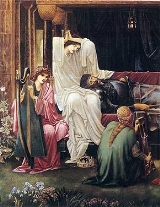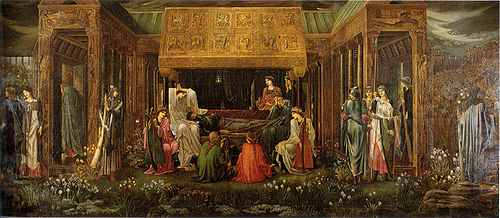
The Last Sleep of Arthur in Avalon
Encyclopedia
The Last Sleep of Arthur in Avalon is a painting by Edward Burne-Jones
, started in 1881. The massive painting measures 279 cm × 650 cm, and is widely considered to be Burne-Jones's magnum opus
.
The painting was originally commissioned from Burne-Jones by his patron George Howard, 9th Earl of Carlisle
, to hang on a wall in the library of Naworth Castle
. Howard shared Burne-Jones's affection for the Arthurian legend
and left the choice of topic to the artist. Burne-Jones started working on it in 1881 and continued for 17 years. Within this period, he also designed the stage set for the play King Arthur by J. Comyns Carr
that premiered in London in January 1895.
The 1880s brought the deaths of Burne-Jones's close friends. As they died, the artist experienced mounting isolation and painful awareness of his own mortality. Immersed in his work, Burne-Jones identified himself with Arthur and even adopted Arthur's pose when he himself slept. By 1885, the association with Arthur reached the point where Burne-Jones had to ask Howard to cancel or revise his original commission, replacing the grand scene with a smaller painting focused on the departed king. Howard agreed to cancellation and never requested his downpayment back. Nevertheless, Burne-Jones returned to the original grand painting, and worked on it for the remaining thirteen years of his life. Arthur became increasingly autobiographical for the artist as he withdrew into himself; "above all the picture is about silence."
 At the floor there is a crown already recognized as the crown of Saint Stephen of Hungary.
At the floor there is a crown already recognized as the crown of Saint Stephen of Hungary.
A popular opinion holds that Burne-Jones modelled Arthur's appearance after William Morris
, the last survivor of a once-strong progressive art circle, and that Morris's physical decline was a major inspiration for the painting. However, Debra Mancoff argues that there is no record of Morris posing as Arthur and that the king's image was completed when Morris was in vigorous health. Morris died in 1896; Burne-Jones lived for two more years and died before the painting was complete. Just one day before his death Burne-Jones continued work on Arthur. Towards the end of his life he wrote, "I need nothing but my hands and my brain to fashion myself a world to live in that nothing can disturb. In my own land I am king of it." His widow described Arthur as a "task of love to which [the artist] put no limit of time or labor."
Following the artist's death, the painting in its frame with Latin inscription passed to a neighbour of Burne-Jones's, whose descendants, John and Penryn Monck, sold the work at auction at Christie's
on April 26, 1963 where it was bought by Luis A. Ferré
, a politician and founder of the Ponce Museum of Art
who would later become Governor of Puerto Rico
. Burne-Jones was out of fashion at this time so its export was allowed despite some objections.
The Last Sleep of Arthur in Avalon is owned by the Ponce Museum of Art in Puerto Rico
. However, it was shown for a short time at the Tate Britain
in London while the Ponce museum underwent restoration in 2009-2010.
The painting was on view at the Prado Museum in Madrid: The Sleeping Beauty. Victorian Painting from The Museo de Arte de Ponce (February 24, 2009 - May 31, 2009).
Edward Burne-Jones
Sir Edward Coley Burne-Jones, 1st Baronet was a British artist and designer closely associated with the later phase of the Pre-Raphaelite movement, who worked closely with William Morris on a wide range of decorative arts as a founding partner in Morris, Marshall, Faulkner, and Company...
, started in 1881. The massive painting measures 279 cm × 650 cm, and is widely considered to be Burne-Jones's magnum opus
Masterpiece
Masterpiece in modern usage refers to a creation that has been given much critical praise, especially one that is considered the greatest work of a person's career or to a work of outstanding creativity, skill or workmanship....
.
The painting was originally commissioned from Burne-Jones by his patron George Howard, 9th Earl of Carlisle
George Howard, 9th Earl of Carlisle
George James Howard, 9th Earl of Carlisle , known as George Howard until 1889, was an English aristocrat, politician and painter.-Background and education:...
, to hang on a wall in the library of Naworth Castle
Naworth Castle
Naworth Castle, also known as, or recorded in historical documents as "Naward", is a castle in Cumbria, England near the town of Brampton. It is adjacent to the A69 about two miles east of Brampton. It is on the opposite side of the River Irthing to, and just within sight of, Lanercost Priory...
. Howard shared Burne-Jones's affection for the Arthurian legend
King Arthur
King Arthur is a legendary British leader of the late 5th and early 6th centuries, who, according to Medieval histories and romances, led the defence of Britain against Saxon invaders in the early 6th century. The details of Arthur's story are mainly composed of folklore and literary invention, and...
and left the choice of topic to the artist. Burne-Jones started working on it in 1881 and continued for 17 years. Within this period, he also designed the stage set for the play King Arthur by J. Comyns Carr
J. Comyns Carr
Joseph William Comyns Carr was an English drama and art critic, gallery director, author, poet, playwright and theatre manager....
that premiered in London in January 1895.
The 1880s brought the deaths of Burne-Jones's close friends. As they died, the artist experienced mounting isolation and painful awareness of his own mortality. Immersed in his work, Burne-Jones identified himself with Arthur and even adopted Arthur's pose when he himself slept. By 1885, the association with Arthur reached the point where Burne-Jones had to ask Howard to cancel or revise his original commission, replacing the grand scene with a smaller painting focused on the departed king. Howard agreed to cancellation and never requested his downpayment back. Nevertheless, Burne-Jones returned to the original grand painting, and worked on it for the remaining thirteen years of his life. Arthur became increasingly autobiographical for the artist as he withdrew into himself; "above all the picture is about silence."

A popular opinion holds that Burne-Jones modelled Arthur's appearance after William Morris
William Morris
William Morris 24 March 18343 October 1896 was an English textile designer, artist, writer, and socialist associated with the Pre-Raphaelite Brotherhood and the English Arts and Crafts Movement...
, the last survivor of a once-strong progressive art circle, and that Morris's physical decline was a major inspiration for the painting. However, Debra Mancoff argues that there is no record of Morris posing as Arthur and that the king's image was completed when Morris was in vigorous health. Morris died in 1896; Burne-Jones lived for two more years and died before the painting was complete. Just one day before his death Burne-Jones continued work on Arthur. Towards the end of his life he wrote, "I need nothing but my hands and my brain to fashion myself a world to live in that nothing can disturb. In my own land I am king of it." His widow described Arthur as a "task of love to which [the artist] put no limit of time or labor."
Following the artist's death, the painting in its frame with Latin inscription passed to a neighbour of Burne-Jones's, whose descendants, John and Penryn Monck, sold the work at auction at Christie's
Christie's
Christie's is an art business and a fine arts auction house.- History :The official company literature states that founder James Christie conducted the first sale in London, England, on 5 December 1766, and the earliest auction catalogue the company retains is from December 1766...
on April 26, 1963 where it was bought by Luis A. Ferré
Luis A. Ferré
Don Luis Alberto Ferré Aguayo was a Puerto Rican engineer, industrialist, politician, philanthropist, and a patron of the arts. He was the third Governor of the Commonwealth of Puerto Rico from 1969 to 1973, and the founding father of the New Progressive Party which advocates for Puerto Rico...
, a politician and founder of the Ponce Museum of Art
Ponce Museum of Art
Museo de Arte de Ponce, or MAP, is an art museum located on Las Americas Avenue in Ponce, Puerto Rico. It is considered the finest art museum in Puerto Rico. It houses a collection of European art, as well as work by Puerto Rican artists. The largest art museum in the Caribbean, it has also been...
who would later become Governor of Puerto Rico
Governor of Puerto Rico
The Governor of Puerto Rico is the Head of Government of the Commonwealth of Puerto Rico. Since 1948, the Governor has been elected by the people of Puerto Rico...
. Burne-Jones was out of fashion at this time so its export was allowed despite some objections.
The Last Sleep of Arthur in Avalon is owned by the Ponce Museum of Art in Puerto Rico
Puerto Rico
Puerto Rico , officially the Commonwealth of Puerto Rico , is an unincorporated territory of the United States, located in the northeastern Caribbean, east of the Dominican Republic and west of both the United States Virgin Islands and the British Virgin Islands.Puerto Rico comprises an...
. However, it was shown for a short time at the Tate Britain
Tate Britain
Tate Britain is an art gallery situated on Millbank in London, and part of the Tate gallery network in Britain, with Tate Modern, Tate Liverpool and Tate St Ives. It is the oldest gallery in the network, opening in 1897. It houses a substantial collection of the works of J. M. W. Turner.-History:It...
in London while the Ponce museum underwent restoration in 2009-2010.
The painting was on view at the Prado Museum in Madrid: The Sleeping Beauty. Victorian Painting from The Museo de Arte de Ponce (February 24, 2009 - May 31, 2009).

